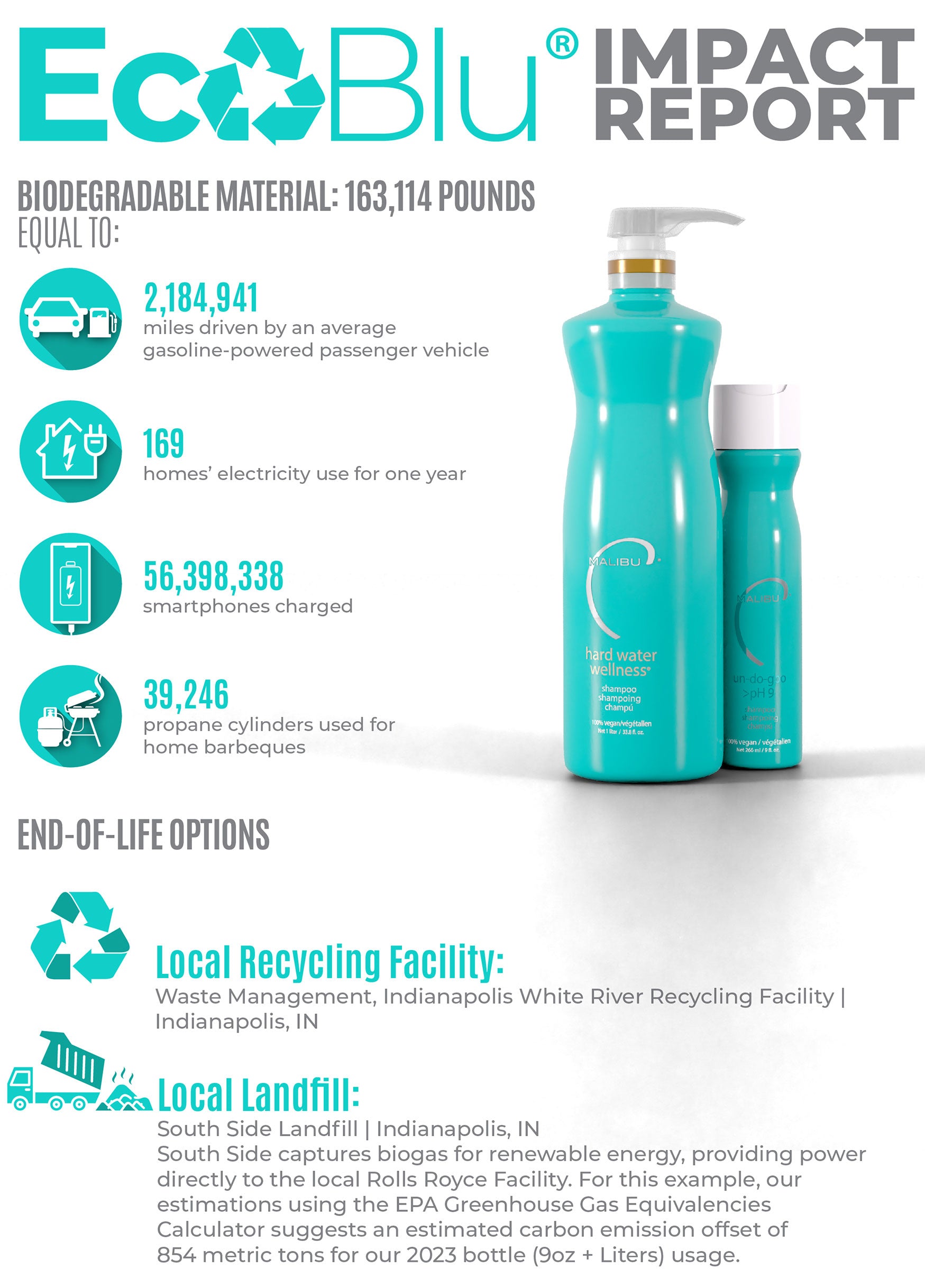Impact Report
We want you to be as excited about recycling and biodegradation as we are! That’s why our goal is to provide as much information as possible about the enhanced biodegradation of our bottles and what we are trying to accomplish. We prefer to use quantifiable numbers and tangible real-world examples of what is possible with our new EcoBlu® bottles.
For the example outlined below, we used our 2023 numbers as if they were EcoBlu® materials (does not include the cap or label). In 2023, Malibu C used 163,114 pounds of plastic for our Maliblu bottles. The below gives you an example of what those bottles, had they been our new EcoBlu® bottles, would have produced if disposed of in a biologically active landfill and their biogases were harnessed for energy.*

We can’t wait to see what 2024 brings and what real world data we will be able provide!
*Eden Research Labs estimates that 50-65% of plastic weight is converted into bio-methane. In our independent ASTM D5511 studies, our bottles product 52.2% CH4 (methane). We used 52.2% in our example above.
*EPA.gov/lmop provides information about U.S. landfills and their renewable energy initiatives. Waste Management, cited in our example above as our local recycling facility, is one of the leaders in landfill biogas energy recovery, capturing 79% of methane at their landfills. With this data, we can estimate how much biogas energy can be captures from our packaging and relate this to other metrics in our daily lives: i.e. miles driven, homes heated, etc.
*Learn more about the EPA Greenhouse Gas Equivalency Calculator HERE.
EcoBlu® Biodegradation Explained
Independent ASTM D5511 tests that represent biologically active landfills on representative packages have shown 60.6% biodegradation in 388 days. This means our EcoBlu® bottles, when disposed of in a biologically active landfill, will biodegrade 60.6% in just 388 days!
The chart below gives you a visual of our EcoBlu® biodegradation in 388 days compared to standard plastic and organic cellulose. (Does not include the caps or labels.)

To further explain this process, we dive into what plastic is. Polymers, also known as plastics, are made of long molecular chains of organic molecules called monomers. Polymers don’t exist in nature, and most are designed to be extremely stable and as a result, they don’t easily biodegrade.
EcoBlu® is made with Eco-One® technology which enhances the biodegradation of Malibu C bottles through a series of chemical and biological processes when disposed of in a biologically active landfill. It allows the plastic to be consumed (as a food energy source) by microbes.

1. FORMATION OF BIOFILM
In a microbe-rich environment, such as a landfill, Eco-One® attracts microbes and these microbes start colonizing on plastic. The enzymes secreted by the microbes turn the plastic hydrophilic (water-loving). As a result, a bio-film that is rich in microbes and moisture forms on and adheres to the surface of the plastic. Microbes then hydrolyze the plastic using secreted enzymes and water.
2. EXPANSION OF THE POLYMER MATRIX
Aggressive accumulation of water expands the plastic matrix and gives the microbes access to the entire polymer matrix. The most likely points of attack on hydrocarbon polymers are at or near the chain ends.
3. INITIAL BREAKDOWN OF POLYMER CHAINS
The microbes break down the large “synthetic” polymer chains into simpler “organic” monomers, thus allowing for the consumption of the polymer matrix. In the process, they secrete certain signaling molecules that other microbes can detect. This signaling process is an invitation to others to come join the feast. Volatile organic fatty acids, hydrogen, and carbon dioxide are formed in the initial stages.
4. BREAKDOWN CONTINUES
Different types of microbes join the feast. Each one uses different elements of the polymer and/or various by-products of the intermediate biological reactions as a food source, breaking down the complex polymer chains. Certain enzymes (from microbes) begin reducing the complex polymer branching while others look for bulkier chains similar to fatty acids. A syntrophic environment containing diverse species of microbes is established to continue the complex chemical steps of biodegradation. Throughout this process, microbes continue to multiply.
5. FINAL STAGES OF BREAKDOWN
During the biodegradation process the molecular weight of the plastic material is reduced and the molecular weight distribution is broadened. The molecular weight reduction has occurred on chains of all lengths in the original plastic material matrix. As individual polymer chains biodegrade, biomass (humus), and biogases (methane and carbon dioxide) are left behind. The carbon dioxide produced in the intermediate steps is being consumed in each subsequent step; therefore, not much is left at the end. The methane can then be captured for energy use.
